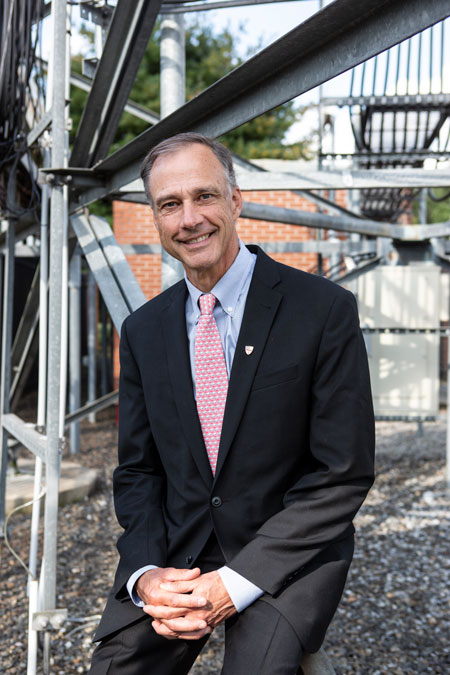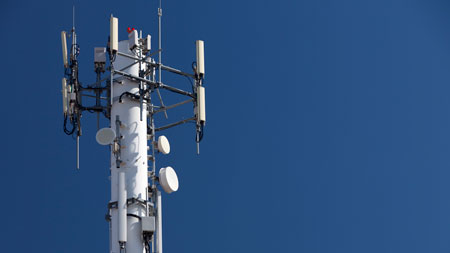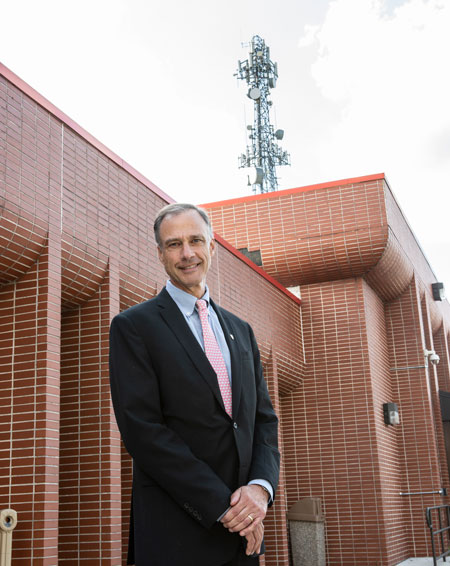Tom Bartlett, president and CEO of American Tower Corp. (NYSE: AMT), has been at the forefront of the evolution of wireless communication for over three decades. Today, he sees mobile technology as more crucial than ever to improving the quality of life for millions of individuals around the globe.
American Tower’s portfolio spans 20 countries and totals more than 180,000 communications sites worldwide, including over 40,000 towers in the United States.
An engineer by training, Bartlett spent 25 years with Verizon Communications before joining Boston-based American Tower in April 2009 to serve as CFO. When Bartlett succeeded Jim Taiclet as CEO in March of this year, he was ready to take the reins after spending more than a decade in the wireless tower business. COVID-19, meanwhile, added a new layer of complexity.
“The decision to bring our employees back into the office is probably one of the most difficult decisions I’ll ever have to make. When you think about people’s safety and wellbeing, it doesn’t get more challenging than that,” Bartlett says.
While acknowledging the unique COVID-induced concerns of the present moment, Bartlett also sees an environment in which American Tower is positioned to thrive, particularly given the company’s position at the intersection of real estate and technology.
Bartlett recently spoke with REIT magazine on issues including the rollout of 5G in the United States, the company’s expansion overseas, the importance of corporate responsibility, and American Tower’s commitment to “connect the unconnected” and make wireless communications possible everywhere.
Although you spent over a decade at American Tower before becoming CEO, was there something uniquely challenging about making that transition at the start of a global pandemic?
Taking on the CEO position in the context of COVID-19 did require quite an immediate adjustment to the responsibilities and priorities of my role.
My number one priority, along with the rest of our management team, was and continues to be to ensure the protection and health and safety of all of our employees, families, and their surrounding communities. We’re working very closely with Massachusetts General Hospital and a number of different parties to ensure that we’ve got the very best resources and information available to be able to bring people back to work safely and to maintain the business that we need and that our customers expect.
What the pandemic has really underscored for me is that now, more than ever, our wireless communications infrastructure is so incredibly crucial in today’s connected world. As we continue to execute our global strategy, we’ve become increasingly focused on our mission of making communications possible everywhere. It’s about connecting the unconnected.
What are the key principles of American Tower’s Stand and Deliver strategy and how do you expect it to evolve over time?
It really is our mission statement. The plan itself has four elements that are focused on company growth and success, while significantly contributing to connectivity worldwide. Those elements are: to lead wireless connectivity around the globe; to innovate for a mobile future; to drive efficiency throughout the industry and within the business; and, to grow our assets (our portfolio of towers and other communications infrastructure) and capabilities to meet customer needs.
The theme uniting these pillars is our continued focus on driving our industry forward. This includes setting high standards for corporate governance, business ethics, and sustainability practices, as well as growth and profitability.
As technology advances, and access to connectivity becomes even more critical and society becomes ever-more dependent on wireless service, we expect to leverage all of the components of our Stand and Deliver strategy to position the company for continued success, particularly as we push ahead into the 5G future.
How do you view the role that REITs, and American Tower in particular, play in 5G deployment?
REITs have a particularly important role in the developing 5G ecosystem. If you think about our digital communications networks today, there are multiple layers facilitated by REIT-owned real estate. Macro tower sites are at the critical intersection of today’s modern networks, serving as the critical connection points between wireless and wired networks throughout the country, as well as facilitating linkages between fiber transport, data centers, and small cells. With 5G, we expect all of these network elements to be even more critical as network demand accelerates and wireless becomes even more ubiquitous in our daily lives.
Wireless towers specifically have been a foundational element of networks since the beginning of the wireless industry. American Tower has been a critical player in the deployment of all network technologies from the first cellular deployments in the early to mid-90s to the rollout of 3G and 4G. And now for 5G, we’re still in the early innings of deployment, clearly, and it’s going to be with us for a decade, and the growth will be incremental.
What is it that makes towers so essential to this evolving wireless landscape?
Macro towers are the most cost and technologically efficient way for service providers to deliver a wireless signal in most areas of the U.S., as well as in most of our other global markets. This will continue to be the case with 5G.
Mobile data usage, meanwhile, is expected to continue to grow at around 30% per year in the U.S., so wireless equipment is going to need to be continuously deployed on our towers to meet this demand. With our nationwide network of more than 40,000 communications sites, we believe we’re well positioned to capture a meaningful portion of the activity in the industry.
There are going to be many players participating in this digital communications transformation, and American Tower is going to be playing a role in 5G from the start. 5G will bring tremendous incremental user demand and REITs are well-positioned to step up and deliver much of the real estate necessary to serve that demand effectively.
What do you see as some of the most exciting capabilities that will come out of 5G?
I think 5G is going to be a technology that will enhance our overall quality of life. Not just in the U.S., but probably even more so internationally.
It’s going to mean many, many new consumer-facing applications, like augmented and virtual reality and immersive video gaming. Much faster speeds on our phones, tablets, and laptops. Higher quality video. Lightning fast downloads. And even more immersive content.
On the enterprise side, we expect things like smart factories, autonomous trucking, the deployment of millions of smart sensors, smart cities, drone delivery systems, and numerous other applications in the commercial sphere.
Essentially, 5G and its capabilities will make all aspects of our lives even more interconnected than they already are—on the personal front, on the business side, and everything in between.
With so many aspects of our daily lives shifting online as a result of the pandemic, there is a new sense of urgency to ensure broadband access for all—particularly in rural areas. How does American Tower do its part to help avoid a growing digital divide?
The disparities in broadband connectivity across the country have been further highlighted through the pandemic, and those without connectivity have been placed at even more of a distinct disadvantage.
Our towers are well-positioned to play a significant role in reducing the connectivity divide; of our more than 40,000 sites in the U.S., the majority are located outside of dense urban city areas, with a substantial portion in rural locations. These sites are already being used for fixed wireless and rural broadband, and we have incremental capacity for more equipment and more tenants on these assets, which can help extend and augment broadband further.
Remote education, telehealth, mobile banking, and a myriad of other critical applications need to be effectively delivered to our rural communities throughout the country, and we want to be a part of that solution.
The reach of the internet also remains significantly limited in rural areas in many developing countries. How is American Tower making efforts to alleviate that problem?
The first thing is being there. We’ve made significant investments over the last 10 years across 20 different markets. These include major developing markets like Brazil, Mexico, Nigeria, South Africa, and India, as well as some earlier stage and several more mature markets.
Throughout much of our international footprint, mobile connectivity serves as the only means of communication and entertainment for citizens given minimal access to fixed-line substitutes, and our sites are the foundation of that connectivity.
As part of our offerings in markets throughout Africa and in India, we are also providing primary power at our tower sites as a result of poor electric grid reliability. We’ve invested in these initiatives and are now ramping up our usage of renewable energy as we power our tenants’ networks.
At the same time, we’ve developed a key global initiative, the Digital Villages program, to bring connectivity to communities that are particularly vulnerable. We partner with wireless carriers, technology partners, and non-profits to close the digital divide by building centers at the base of our towers that have a secure power source and computers with broadband access. In many rural areas in which they are installed, these are the first broadband connections available to the local population.
What type of innovation initiatives is American Tower exploring?
We’re investing in a very focused way on four initiatives that include: looking at ways to provide a computing capability at our macro sites that sit at the edge of a network, which brings data closer to users; exploring new opportunities to expand the market for indoor networks; providing more renewable efficient power sources near our macro sites; and looking at extending our international platform.
We’re quite proud of the process that we have in place to drive these initiatives, but this is not something that’s going to happen overnight.
How has American Tower’s international strategy evolved in recent years?
We have operated in international markets since the late 1990s and in recent years have significantly expanded our global footprint. Fundamentally, our strategy has remained the same.
Generally speaking and collectively, we expect the rate of growth in our international markets to be faster than that of our U.S. market over the long term. Typically, these markets are one to two technologies behind the U.S. and so in many of the developing markets there may be 3G and 4G services being deployed, as opposed to 4G and 5G.
In many cases, less than 10% of the population have a wireline connection so our customers in these markets are investing all of their resources into wireless technology.
How does growth compare across the different regions?
In the U.S., we have been able to generate consistent growth for the last two decades, and we believe that our international markets as a whole can grow even faster over a longer period of time given their relatively earlier stage of technology development in aggregate.
There is a broad spectrum of growth rates depending on the region as well – European growth rates tend to be lower given those markets are fairly mature. Africa, on the other hand, has been generating the highest growth rates in the business as of late. Latin America and India should be somewhere in-between over the long-term.
American Tower recently signed a 15-year master lease agreement (MLA) with T-Mobile. Why is that significant?
This agreement, which is the longest in our history, augments our strategic relationship with T-Mobile. We are excited to work closely with T-Mobile as they deploy 5G across the country, and this agreement should benefit both of us in that process.
Racial and social justice awareness has accelerated during 2020. What are you and American Tower doing to ensure the company is an inclusive place for all?
Racism has no place in our organization. Full stop. We really strive to have our business be a beacon for all others to follow. Our foundation recently pledged $1 million to counter systemic racism and will partner with organizations focused on social justice. We’ve also rolled out an internal 2:1 employee matching gift Campaign for Racial Justice.
This summer, I started listening sessions with employees across the country to hear about their experiences and concerns firsthand. The result of that is the creation of a CEO Advisory Council. It’s going to look at things like recruiting, career development, and employee engagement to identify action items and next steps for us as a company.
We know there is more that we can, and will, do. This is a global issue and one that I feel very passionate about. We’re learning, we’re sharing, we’re talking, and we’re opening up all kinds of opportunities for people to make it a more inclusive and cohesive culture.
What role does American Tower see in terms of setting a strong example globally in environmental stewardship?
Our business model is fundamentally green and aimed at reducing the environmental footprint of modern wireless networks by hosting multiple tenants on a single communications site.
In the U.S., we achieved carbon-neutral status in 2019 through purchasing renewable energy certificates and carbon offsets. We’ve also made significant investments in renewable energy, particularly in our African and our Indian markets where we have set significant long-term goals for reducing our fossil fuel usage.
We have also taken proactive steps to go above and beyond from an environmental stewardship perspective. This includes a partnership with American Forests for our Million Trees initiative, a ten-year plan to plant a million trees in the U.S. This year, that initiative became part of the World Economic Forum’s Trillion Trees global initiative. We’ve already planted more than 200,000 of the million trees promised, which will remove an estimated 200,000 metric tons of carbon dioxide from the air over the next 40 years.
We’re also driving positive change in a number of other areas, such as fossil fuel consumption and renewable energy initiatives, which you can read about in our 2019 sustainability report.
What is it about telecommunications that has kept you interested for most of your career?
It’s been a combination of curiosity about the technology and passion for what I think a company like American Tower is capable of and the commitment that it’s making to the world at large. Our teams are making a difference in peoples’ lives on a global basis and we as an industry can do so much more. That keeps me driving forward.


